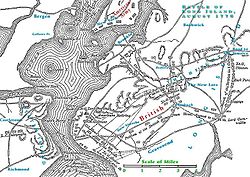See also: Timeline of Brooklyn
The history of European settlement in Brooklyn spans more than 350 years. The settlement began in the 17th century as the small Dutch-founded town of "Breuckelen" on the East River shore of Long Island, grew to be a sizable city in the 19th century, and was consolidated in 1898 with New York City (then confined to Manhattan and part of the Bronx), the remaining rural areas of Kings County, and the largely rural areas of Queens and Staten Island, to form the modern City of New York.Colonial era
Six Dutch towns
The Dutch were the first Europeans to settle Long Island's western edge, which was then largely inhabited by the Lenape, a Native American people who are often referred to in contemporary colonial documents by a variation of the place name "Canarsie". The "Breuckelen" settlement, named after Breukelen in the Netherlands, was part of New Netherland, and the Dutch West India Company lost little time in chartering the six original parishes (listed here first by their later, more common English names):[11]- Gravesend: in 1645, settled under Dutch patent by English followers of the Anabaptist, Lady Deborah Moody, possibly after Gravesend, England, or 's-Gravenzande, Netherlands
- Brooklyn Heights: as "Breuckelen" in 1646, after the town now spelled "Breukelen", Netherlands
- Flatlands: as "New Amersfoort" in 1647
- Flatbush: as "Midwout" in 1652
- New Utrecht: in 1657, after the city of Utrecht, Netherlands
- Bushwick: as "Boswijck" in 1661
A typical dining table in the Dutch village of Brooklyn, c. 1664, from The Brooklyn Museum.
Six townships in an English province
Village of Brooklyn and environs, 1766
The English reorganized the six old Dutch towns on southwestern Long Island as Kings County on November 1, 1683,[13] one of the "original twelve counties" then established in New York Province. This tract of land was recognized as a political entity for the first time, and the municipal groundwork was laid for a later expansive idea of Brooklyn identity.
Lacking the patroon and tenant farmer system established along the Hudson River Valley, this agricultural county unusually came to have one of the highest percentages of slavery among the population in the "Original Thirteen Colonies" along the Atlantic Ocean eastern coast of North America.[citation needed]
Revolutionary War
Further information: Battle of Long Island and New York and New Jersey campaign
The Battle of Long Island was fought across Kings County.
Washington, viewing particularly fierce fighting at the Gowanus Creek from atop a hill near the west end of present-day Atlantic Avenue, was famously reported to have emotionally exclaimed: "What brave men I must this day lose!".[15]
The fortified American positions at Brooklyn Heights consequently became untenable and were evacuated a few days later, leaving the British in control of New York Harbor. While Washington's defeat on the battlefield cast early doubts on his ability as the commander, the tactical withdrawal of all his troops and supplies across the East River in a single night is now seen by historians as one of his most brilliant triumphs.[15]
The British controlled the surrounding region for the duration of the war, as New York City was soon occupied and became their military and political base of operations in North America for the remainder of the conflict. The British generally enjoyed a dominant Loyalist sentiment from the residents in Kings County who did not evacuate, though the region was also the center of the fledgling—and largely successful—American intelligence network, headed by Washington himself.
The British set up a system of notorious prison ships off the coast of Brooklyn in Wallabout Bay, where more American patriots died of intentional neglect than died in combat on all the battlefields of the American Revolutionary War, combined. One result of the Treaty of Paris in 1783 was the evacuation of the British from New York City, celebrated by residents into the 20th century.



No comments:
Post a Comment